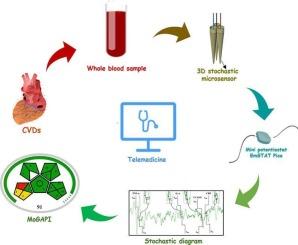Simultaneous determination of interleukin-6, vascular cell adhesion molecule-1, C-reactive protein, and tumor necrosis factor-α – A key factor in early prognosis of cardiovascular diseases for obese youngsters
IF 4.9
2区 化学
Q1 CHEMISTRY, ANALYTICAL
引用次数: 0
Abstract
Cardiovascular diseases became one of the primary causes of mortality for obese young people. Determination of biomarkers such as C-reactive protein, tumor necrosis factor α, interleukin-6, and vascular cell adhesion molecule-1, may contribute to the prognosis as well as to early diagnosis of cardiovascular diseases. A 3D stochastic microsensor based on single-wall carbon nanotubes decorated with gold nanoparticles and modified with quinine was designed, characterized, and validated for the qualitative and quantitative determination of C-reactive protein, tumor necrosis factor α, interleukin-6, and vascular cell adhesion molecule-1. Wide working concentration ranges were recorded for all biomarkers, while the limits of determination were of 4.1 × 10−15 μg mL−1 for interleukin-6, 5.0 × 10−14 μg mL−1 for TNF-α, and 1.00 × 10−21 g mL−1 for C-reactive protein, and vascular cell adhesion molecule-1. The recovery tests shown that the biomarkers were recovered in percentages higher than 99.10 % and RSD% values below 0.03 %.

同时检测白细胞介素-6、血管细胞粘附分子-1、c反应蛋白和肿瘤坏死因子-α -是影响肥胖青少年心血管疾病早期预后的关键因素
心血管疾病成为肥胖年轻人死亡的主要原因之一。生物标志物如c反应蛋白、肿瘤坏死因子α、白细胞介素-6和血管细胞粘附分子-1的测定可能有助于心血管疾病的预后和早期诊断。设计了一种基于纳米金修饰的单壁碳纳米管三维随机微传感器,并对其进行了表征和验证,用于c反应蛋白、肿瘤坏死因子α、白细胞介素-6和血管细胞粘附分子-1的定性和定量检测。所有生物标志物均记录了较宽的工作浓度范围,其中白细胞介素-6的检测限为4.1 × 10−15 μ mL−1,TNF-α的检测限为5.0 × 10−14 μ mL−1,c反应蛋白和血管细胞粘附分子-1的检测限为1.00 × 10−21 g mL−1。回收率试验表明,生物标志物的回收率大于99.10%,RSD%小于0.03%。
本文章由计算机程序翻译,如有差异,请以英文原文为准。
求助全文
约1分钟内获得全文
求助全文
来源期刊

Microchemical Journal
化学-分析化学
CiteScore
8.70
自引率
8.30%
发文量
1131
审稿时长
1.9 months
期刊介绍:
The Microchemical Journal is a peer reviewed journal devoted to all aspects and phases of analytical chemistry and chemical analysis. The Microchemical Journal publishes articles which are at the forefront of modern analytical chemistry and cover innovations in the techniques to the finest possible limits. This includes fundamental aspects, instrumentation, new developments, innovative and novel methods and applications including environmental and clinical field.
Traditional classical analytical methods such as spectrophotometry and titrimetry as well as established instrumentation methods such as flame and graphite furnace atomic absorption spectrometry, gas chromatography, and modified glassy or carbon electrode electrochemical methods will be considered, provided they show significant improvements and novelty compared to the established methods.
 求助内容:
求助内容: 应助结果提醒方式:
应助结果提醒方式:


